2022 Academic Partners
Canadian Coast Guard
Principal Investigators, postdoctoral fellows, and graduate students at Canadian universities have partnered with Canadian government scientists on several projects as part of the 2022 IYS Pan-Pacific Winter High Seas Expedition. They will explore oceanography, eDNA, salmon diets, acoustics, salmon migration routes and much more. You can read more about the projects and the people involved below. These projects were made possible by funding provided by the British Columbia Salmon Restoration and Innovation Fund.
Phytoplankton Dynamics of the Subarctic Pacific: A Bioregionalization Approach
Marta Konik, PhD (University of Victoria)
Project Summary:
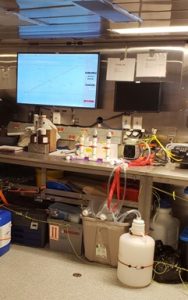 Phytoplankton constitute the first trophic level controlled by the sunlight availability and the physical and chemical water properties, directly affecting communities’ abundance and composition. The dynamic adjustment of the phytoplankton makes them helpful in tracking complex environmental changes and identifying risks for the higher trophic levels. This project aims to identify bioregions of similar phytoplankton phenology and the taxonomic structure. This is possible because, generally, phytoplankton groups have a characteristic set of pigments that influence the resultant ocean colour. The modern satellites measuring ocean colour can detect fine changes in the pigment composition, which allows for identifying the main phytoplankton functional groups and defining the phenology patterns.
Phytoplankton constitute the first trophic level controlled by the sunlight availability and the physical and chemical water properties, directly affecting communities’ abundance and composition. The dynamic adjustment of the phytoplankton makes them helpful in tracking complex environmental changes and identifying risks for the higher trophic levels. This project aims to identify bioregions of similar phytoplankton phenology and the taxonomic structure. This is possible because, generally, phytoplankton groups have a characteristic set of pigments that influence the resultant ocean colour. The modern satellites measuring ocean colour can detect fine changes in the pigment composition, which allows for identifying the main phytoplankton functional groups and defining the phenology patterns.
To achieve our goals, the first step was gathering information about the phytoplankton pigments during the High Seas Expeditions conducted in 2019 and 2020 and the Pan-Pacific in 2022. The water samples collected on board the ships were transported and analyzed in the laboratory using high-performance liquid chromatography (HPLC), which determined the pigments’ concentrations, essential to infer about the phytoplankton groups present in the sea.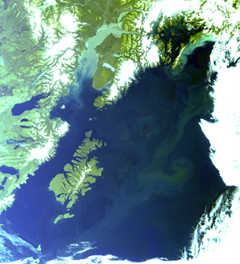
In the second step, the phytoplankton pigment data were referenced to the satellite-measured reflectance data retrieved from the Globcolour product of merged several ocean colour sensors’ data. Those data sets were used to develop the new satellite-derived phytoplankton groups and phenology products covering the entire Subarctic Pacific in the years 1998 to 2022, which were the base for outlining the bioregions. Such a division helps to track interannual variability and long-term changes in plankton communities and associated responses to climate change, which may affect regions in different ways and to different degrees. Characterizing the spatial phytoplankton diversity and phenology gives an insight into the Pacific salmon’s living environment during the marine life stage, helps to reveal possible threats for the populations, and provides knowledge critical to build management strategies ensuring salmon survival.
Environmental DNA
Christoph Deeg, PhD (University of British Columbia)
Project Summary:
In collaboration with the Miller lab at the Department of Fisheries and Oceans and the Pacific Salmon Foundation, my project deploys genomic tool to describe the winter ocean from a salmon’s perspective. To accomplish this, we use a two-pronged approach where “Fit-Chips” tell us about health of salmon and environmental DNA allowing us to describe the ecosystem that salmon in habit.
Fit-Chips, developed in the laboratory of Dr. Kristi Miller, we screen salmon for infectious agents using quantitative PCR, much like in the initial covid tests. On the Fit-Chips however, we are able to screen for 47 different infectious agents simultaneously. Additionally, we screen the gene expression profile of the salmon themselves to learn what stressors (e.g. inflammation, viral infections, hypoxia) individuals are experiencing. In samples from past IYS expeditions we have found significantly less infections in the open ocean compared to salmon sampled in coastal waters but have also detected a connection between prey availability and immune function in overwintering salmon. The samples from the 2022 expedition represent our most extensive dataset to date and preliminary analysis revealed a decrease in pathogen prevalence in sockeye from the east to west, amongst other observations.
Environmental DNA (eDNA) is the study of the genetic material left behind in the environment by all kinds of organisms, from microbes to whales. We use eDNA to learn about aquatic ecosystems by analyzing the DNA contained in a sample of filtered sea water. In past IYS expedition, eDNA has allowed us to detect salmon, their prey, and predators at levels that outperformed traditional sampling methods, some of the latter were not observed by any other method. Together, we were able to paint a detailed picture of the open ocean ecosystem of the North Pacific from a salmon’s perspective and uncovered how marine heat waves impact the ecosystem with trickle down effects on salmon. By utilizing innovative sampling strategies during the 2022 IYS expedition, we were to collect samples from a larger spatial area at higher than ever before. We have now teamed up with international collaborators to combine our eDNA data with high resolution oceanographic data. With this, we aim to identify the biological and oceanographic factors associated with hotspots of biological activity. Understanding how this translates to prey availability for salmon, and interactions with competitors and predators, will improve our understanding of ocean ecosystem health and salmon ocean survival.
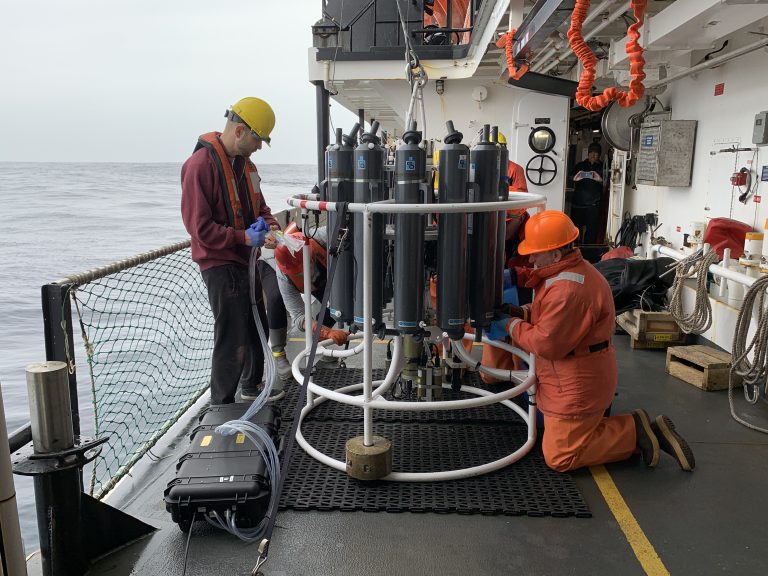
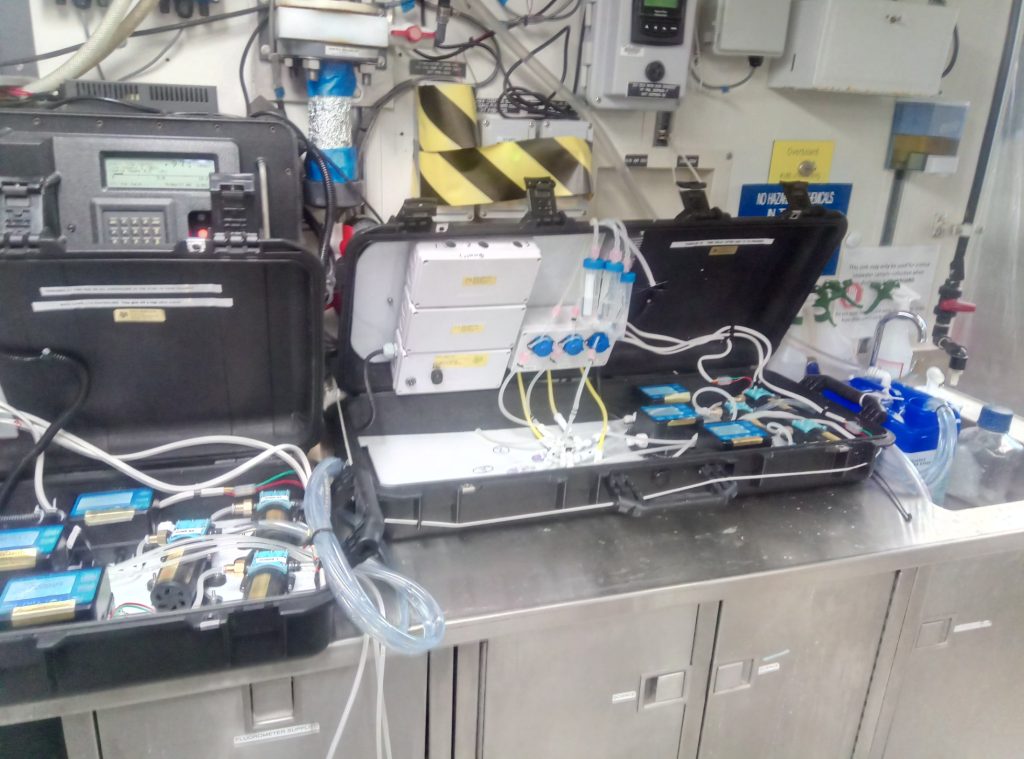
North Pacific Food Webs
Genyffer Troina, PhD (University of British Columbia)
Project Summary:
Foraging ecology is a critical factor in salmon growth and survival on the high seas. Understanding food web dynamics during the high sea’s life stage is key to assessing interspecific trophic interactions, such as predator-prey relationships and competition, that determine the quantity and quality of food available to salmon. The winter period in particular is expected to be a critical period for salmon, since this is when ocean productivity is at its lowest. Furthermore, since 2013 we have entered into unchartered waters in the North Pacific, with intense heat wave activity potentially leading to shifts in the structure of the food webs that support salmon. There is an urgent need to resolve salmon food ecology on the high seas so that we can understand the impacts of these changes.
The International Year of the Salmon (IYS) sample sets from the 2019, 2020, and 2022 expeditions are being used to develop a comprehensive understanding of overall food web structure, salmon feeding ecology (prey, trophic niche, competition), and to correlate these with salmon health. In this project, I am working with Dr. Brian Hunt and other collaborators using chemical tracers to understand salmon food web structure in the eastern North Pacific. We are analyzing carbon and nitrogen stable isotopes and fatty acid composition in the tissues of the different organisms that comprise these pelagic food webs, from particulate organic matter (POM) and small invertebrates to large pelagic fish, including the five salmon species. Our analyses of the spatial and temporal (2019-2022) dynamics of the North Pacific food web structure, including species trophic positions, nutritional quality, and trophic pathways, will help to understand the effect of ocean conditions on interspecific interactions that may cascade up the food webs and ultimately affect salmon.
Our preliminary analysis of data from the 2019 expedition suggests that myctophids and squids occupy similar trophic positions to salmon, and might represent important competitors for food in the high seas. In addition, our data indicate that oceanographic conditions are associated with gradients in the structure of these pelagic food webs, with organisms having higher trophic levels and salmon feeding on a larger variety of prey in the southeastern Gulf of Alaska, an area with higher temperatures and lower nutrient concentrations than the northeastern Gulf of Alaska. The samples collected during the 2022 IYS expeditions, representing the entire eastern North Pacific, are currently being processed for stable isotope and fatty acids and will provide a deeper understanding of the structure and dynamics of salmon food webs, inter and intra-specific competition, and salmon nutritional health. In the current scenario of climate changes, it is imperative to understand how ocean conditions affect prey availability and food web dynamics in the North Pacific. These data are also informing the development of food web models that will provide insight into the main pathways that sustain higher trophic level consumers, and the direct and indirect effects of species interacting within the northeast Pacific ecosystems.
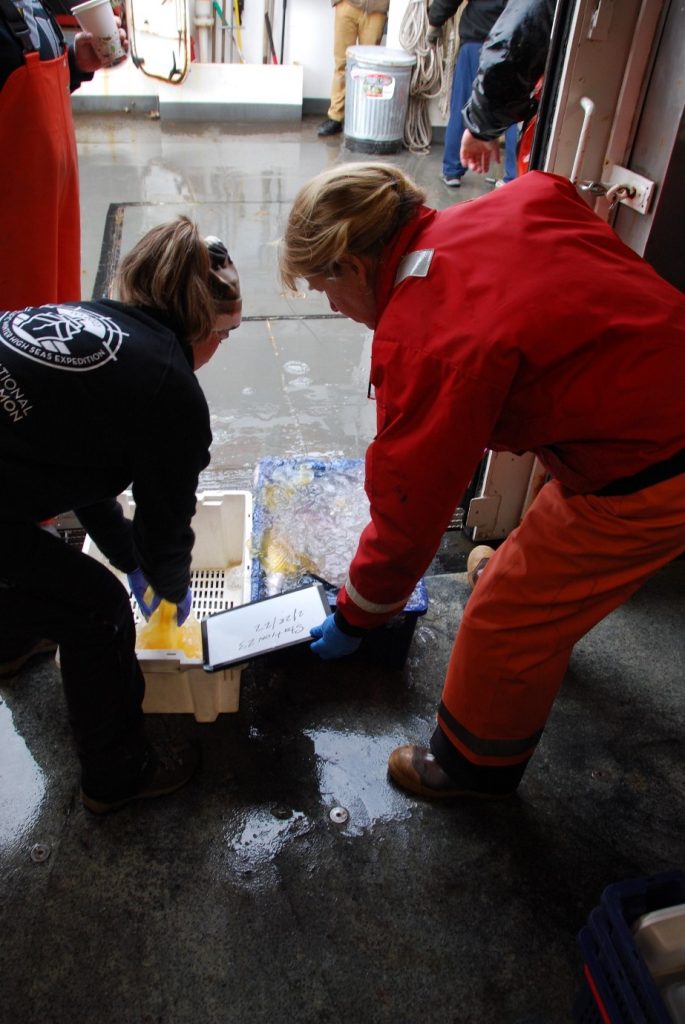
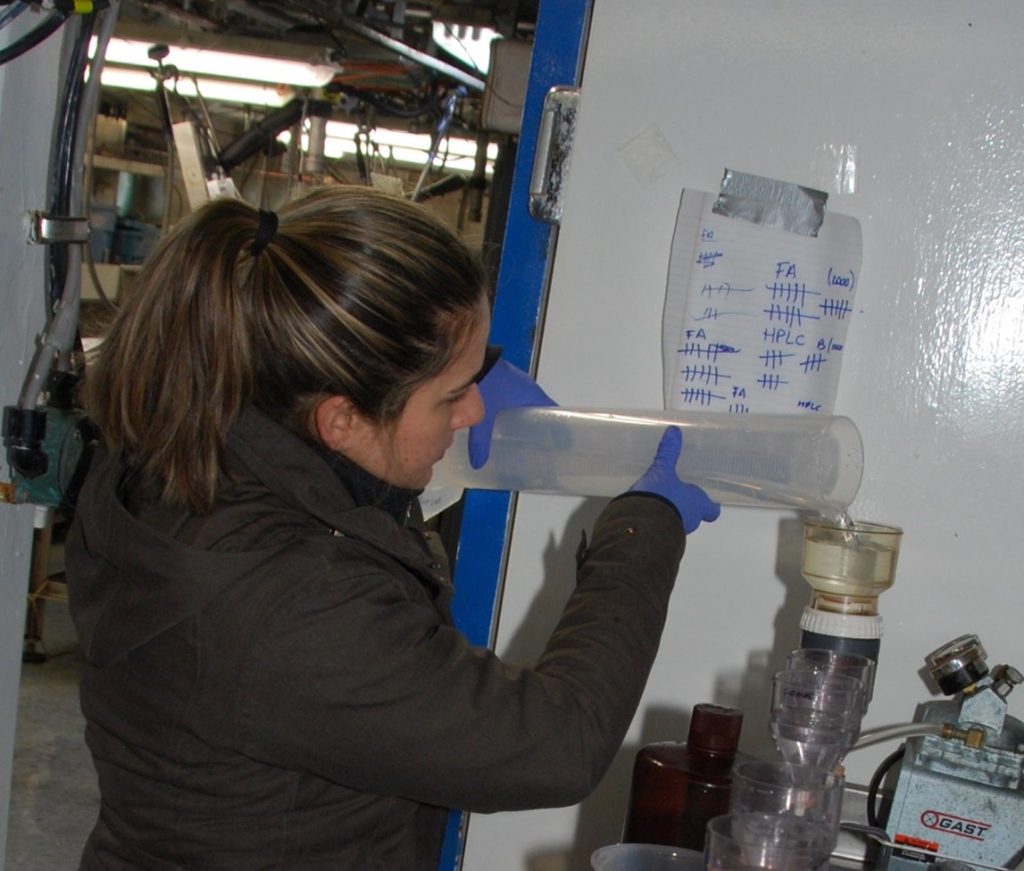
Integrating Echosounder Abundance Measures with Net Samples to Quantify Salmon Prey Communities in the North Pacific Ocean
Nicolas Ens, PhD Candidate (University of Victoria)
Project Summary:
It is well known that salmon migrate out to the north Pacific Ocean to eat and grow, but just how much food is out there for them in the winter, and is it enough to sustain salmon populations? My project, in collaboration with the Dower lab at the University of Victoria, Fisheries and Oceans Canada, and the IYS, is combining old-school prey sampling with high-tech echosounder observations to answer these questions. I was out on the Canadian ship “CCGS Sir John Franklin” for the IYS 2022 Pan-Pacific Expedition and used two very different tools to look at the prey of salmon (zooplankton and fish) in the north Pacific Ocean.
To find out exactly what species of zooplankton and small fish were present for salmon to eat, and in what numbers, we used a net system called a “Tucker trawl” to catch small animals at discrete sampling stations. This system is better at catching larger, faster zooplankton than traditional “bongo” nets, but man did it give us a lot of trouble while we were trying to fish with it. Thankfully we managed to collect animals at most stations, which we then preserved and later counted and identified in the lab. Thus, we were able to find out exactly the kinds of zooplankton and fish which salmon are swimming around with and might be eating!
Unfortunately, the north Pacific Ocean is pretty big, so our sampling stations had to be spaced far apart to cover the whole area in a reasonable time. This meant we could have missed whole areas where zooplankton could be grouped without ever knowing. This is where the second facet of our research comes in – active acoustic monitoring. Each of the survey ships on the 2022 Pan-Pacific Expedition was equipped with echosounders – fancy underwater speakers that emit “pings” of sound and listen for echoes from anything in the water. Because zooplankton and fish are a different density from water, some of the sound bounces off them and is detected by the echosounder. This lets us detect the numbers of (and even the general types of) zooplankton in the water without even needing to use a net! We had the echosounders running for most of the time while we were out at sea, so we now have data that will allow us to estimate how many zooplankton and fish were where each ship was at a given time, and what they were up to.
By combining the detailed but space-limited data that the Tucker trawls give us with the coarse but ever-present echosounder data, we will be able to estimate how many zooplankton and fish were in an area, and what kinds of zooplankton and fish make up those numbers. This will allow us to produce better estimates of what kinds of food and how much of it is available to salmon in the north Pacific Ocean than ever before. This information will help understand if an insufficiency of food is causing declines of Pacific salmon stocks.
Environmental DNA (eDNA) is an emerging field to study the diversity and distribution of aquatic communities without the need to capture individuals. This allows for an unbiased account of low abundance species or species that are difficult to capture, such as large, highly mobile predators. eDNA samples will be collected onboard the 2022 IYS Expedition to analyze for the presence of chordates, cephalopods, and invertebrates to complement catch data from the Expedition. The eDNA data will provide an unbiased approach to document the spatial and temporal variation in distribution, condition, and standing stocks of zooplankton, nekton as well as competitors and predators of salmon. Furthermore, this technology might allow for future low-impact biodiversity assessments using remotely operated sampling equipment. The preliminary eDNA results from the IYS 2019 and 2020 International Gulf of Alaska Expeditions have revealed several potential salmon predators in the survey zone, including orcas, salmon sharks and porpoises.
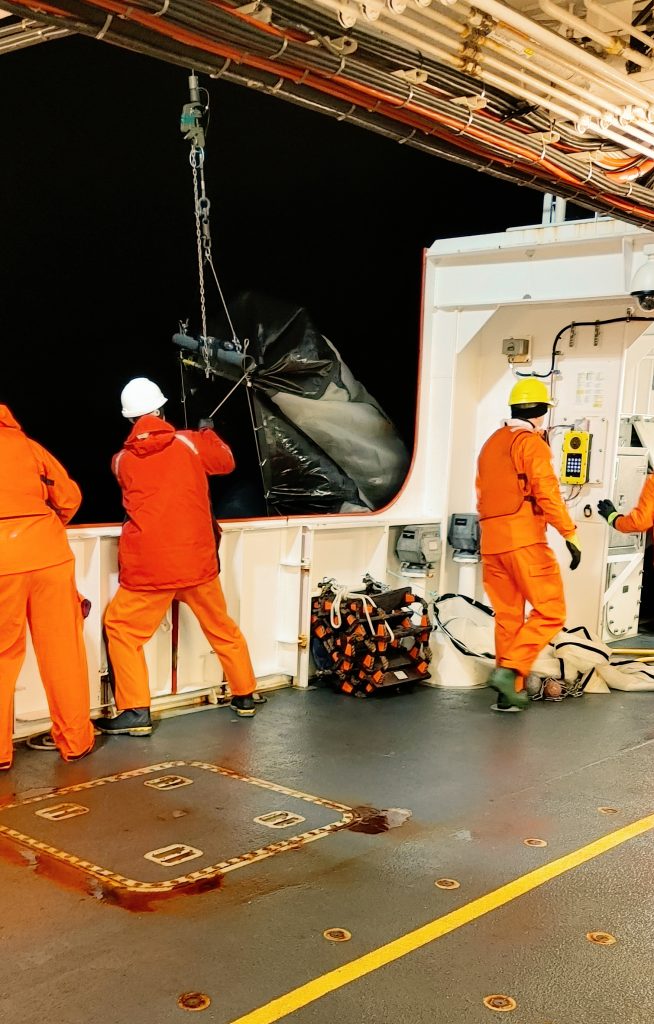
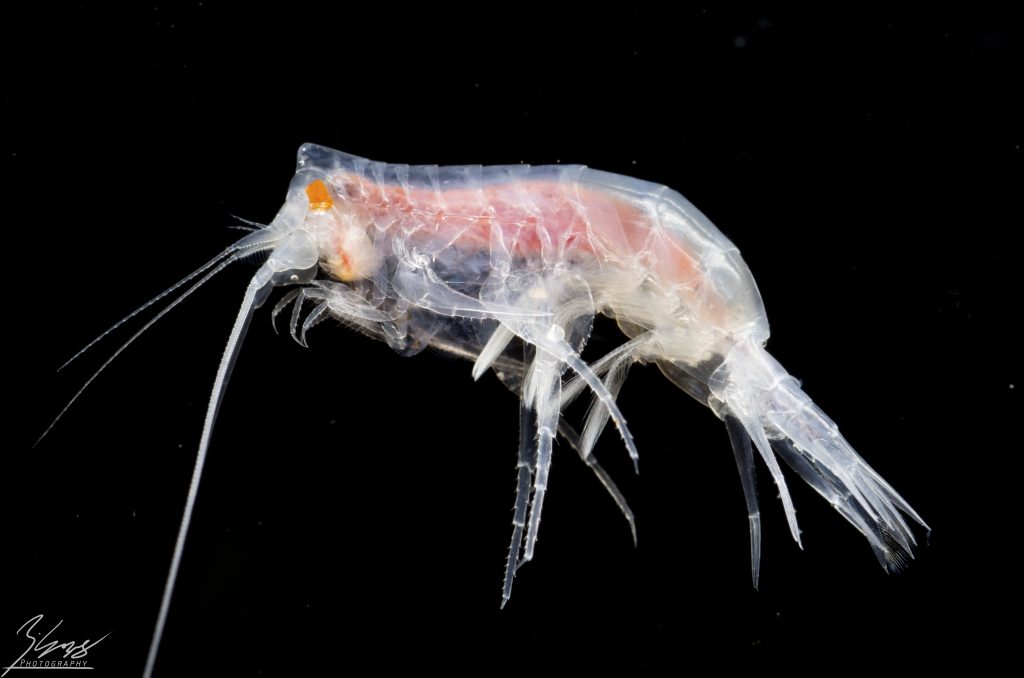
Pacific Salmon Trophodynamics in the Subarctic Gyres: an Ecosystem Modelling Approach
Szymon Surma, Postdoctoral Fellow (University of British Columbia)
Project Summary:
The primary aim of my project is to elucidate key questions in the pelagic ecology of Pacific salmon by investigating subarctic Pacific ecosystem structure and dynamics. These questions include the relative importance of bottom-up and top-down control in the pelagic ecology of salmon, the uniqueness and mechanism of a postulated trophic cascade driven by pink salmon, differences in carrying capacity across salmon species and regions of the subarctic Pacific, the importance of competition among salmon species and between hatchery-raised and naturally spawning salmon, projected adverse impacts of intermittent marine heatwaves and long-term ocean warming on salmon production, and the plausibility of postulated beneficial bottom-up effects of exogenous iron inputs to the epipelagic subarctic Pacific on salmon production. In order to address these questions, my colleagues and I have developed an ensemble of ecosystem models to represent the distribution, flux, and cycling of biomass, energy, and a limiting micronutrient (iron) through pelagic ecosystems of the western and eastern subarctic Pacific (Figure 1), with a particular focus on Pacific salmon, their predators, prey, and competitors. These models include epipelagic and mesopelagic organisms and span all size classes and trophic levels from whales to phytoplankton.
This set of models, representing ecosystem states prevailing in the western and eastern subarctic Pacific in the early 1990s (Figure 2), is now complete. Some challenges we needed to overcome in the course of this research included the somewhat limited availability of the data necessary of modelling pelagic ecosystems compared to their coastal counterparts, as well as the integration of data from multiple countries in the current international political situation. Preliminary results of this research suggest the potential for interspecific competition among Pacific salmon and the importance of sharks and marine mammals among salmon predators in the subarctic Pacific.
In the next stage of our research, the static ecosystem models will be fitted to time series comprised of biomass and catch data for model functional groups (i.e. species or sets thereof sharing basic ecological characteristics), as well as physical and biological oceanographic data, to elucidate the drivers of ecosystem dynamics in the eastern and western subarctic Pacific, and their impacts on salmon ecology, over the past three decades. These fitted ecosystem models will then be employed in simulations of past, present, and future ecosystem dynamics to address the research questions outlined above. We hope this research will help explain recent spatial and temporal patterns in Pacific salmon productivity and mortality and illuminate the importance of the pelagic phase in the life cycles of Pacific salmon.

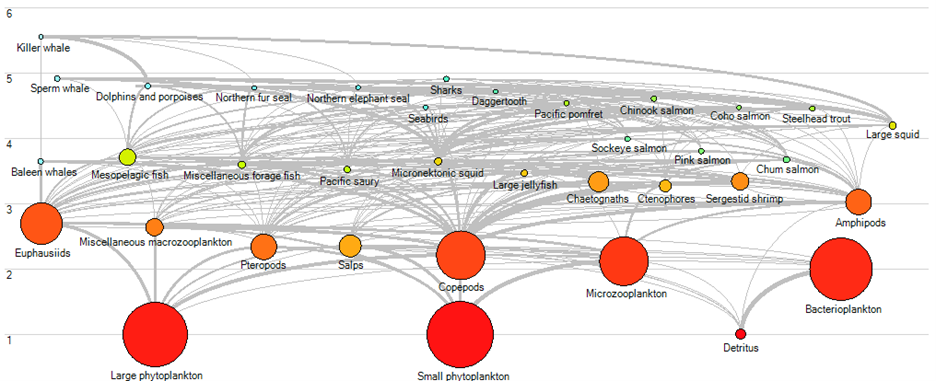
North Pacific Zooplankton Ecology
Joanne Breckenridge, PhD (University of British Columbia)
Project Summary:
Zooplankton are an important food resource of salmon and other high trophic level marine species. Analysis of zooplankton samples collected during the 2019, 2020, and 2022 IYS expeditions will provide foundational information on spatial variation in zooplankton abundance, biomass, and community composition across the eastern North Pacific during winter and early spring, contributing to understanding of the feeding landscape experienced by salmon on the high seas. Our project’s first aim is to describe and explain spatial variation in zooplankton community composition and biomass with respect to oceanographic data collected during the expeditions and via satellite.
A total of 196 samples were collected for zooplankton taxonomy using bongo nets during the 3 IYS expeditions. Processing of these samples has recently been completed. In total, approximately 300 taxonomic groups belonging to over 80 families and 14 phyla were identified. For many taxonomic groups, valuable information on developmental stage and sex composition was recorded. Multiple taxonomists contributed to these analyses, and currently differences in taxonomic resolution and identification are being resolved and harmonized so that a single standardized data set can be produced for analysis.
The harmonized zooplankton dataset will be analyzed to determine the spatial and temporal dynamics of the eastern North Pacific zooplankton community in relation to oceanographic conditions. Subsequently, zooplankton species distribution, biomass, and abundance communities during the IYS expeditions will be compared to historical datasets. The breadth of data available through the IYS project provides a unique opportunity to learn more about the ecology of zooplankton in the North Pacific and lay down the baseline for winter zooplankton data that will fuel research for years to come.
Copper-Binding Ligands in Seawater from the CCGS Sir John Franklin
Richard L. Nixon, Andrew R.S. Ross, Jay T. Cullen, Angelica Peña (University of Victoria)
Project Summary:
Trace metals are utilized by phytoplankton communities as nutrients to drive primary productivity in the ocean but copper bioavailability is strictly controlled by small organic ‘ligand’ molecules in seawater. Our project provides a biochemical perspective on metal-algae ecology in the Northeast Pacific Ocean by using novel methods to characterize copper ligands in terms of their geospatial distribution, chemical properties, and potential sources. Samples collected aboard the CCGS Franklin as part of the 2022 IYS collaboration are being processed and analyzed at the University of Victoria by affinity chromatography and UV-Vis spectrophotometry, adding to a growing library of isolates for further chemical interrogation – including samples taken from multiple cruises of the same region in past years. Developing a fundamental understanding of the factors necessary for phytoplankton growth, and how those factors correlate with primary productivity over time, is especially important as anthropogenic activities continue to impact the chemical makeup of marine environments. We are excited to be a part of the IYS program and hope our project will provide to the growing body of marine trace metal research guiding sustainable ocean management policies regarding industrial pollution and ocean fertilization.

